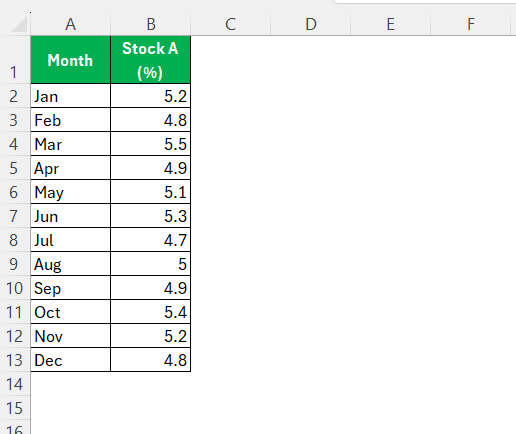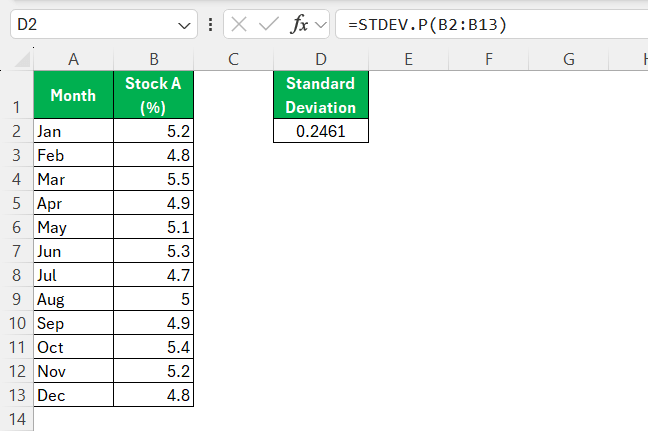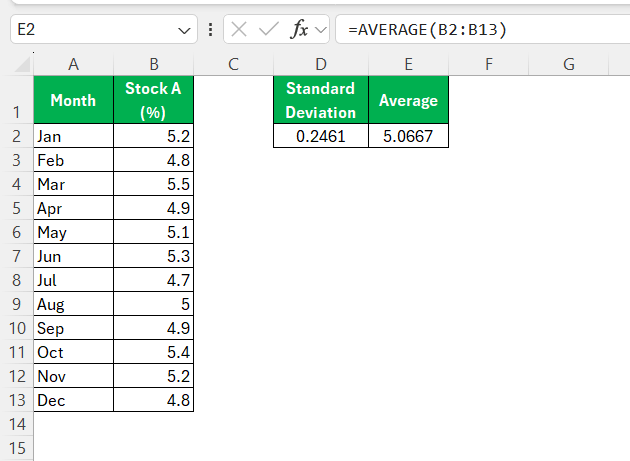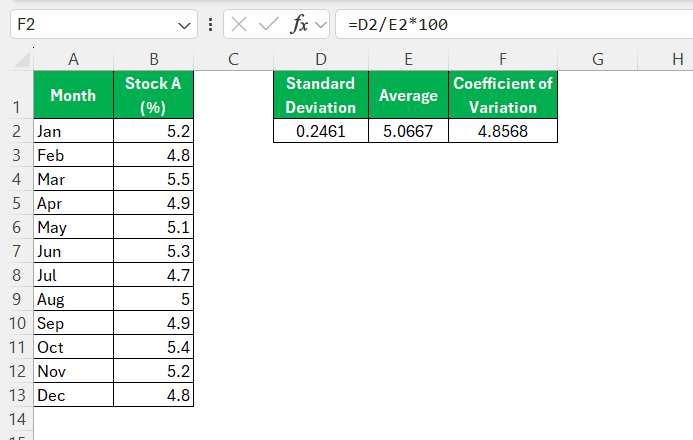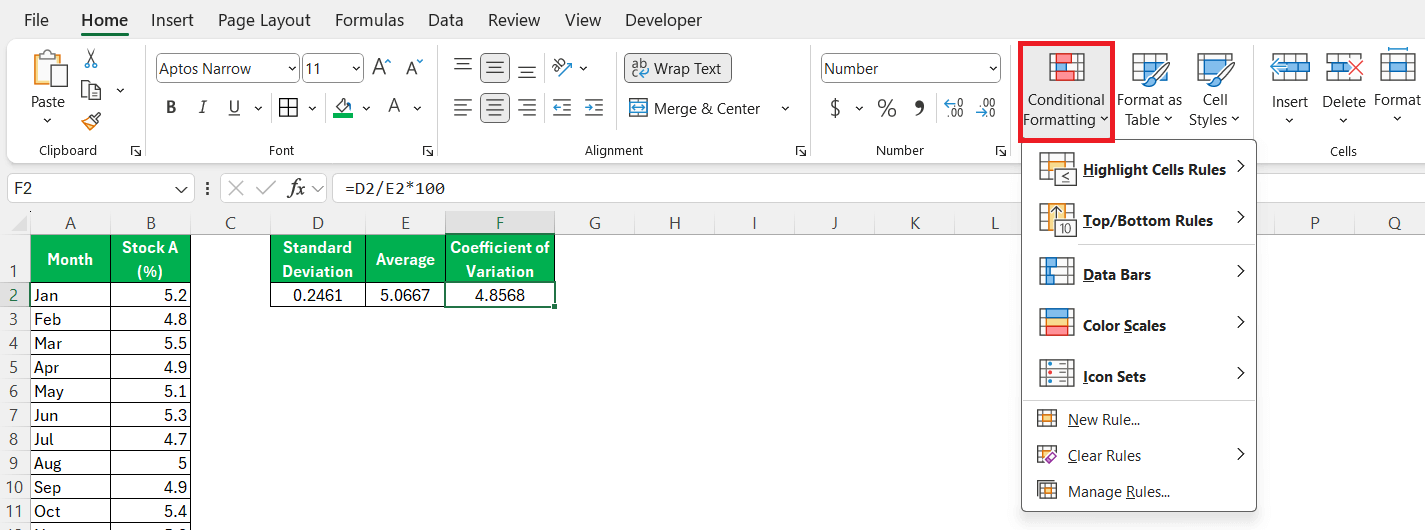When working with data in Excel, I often need to compare the variability of different datasets. One of the best ways to do this is by calculating the Coefficient of Variation (CV). The CV is a useful statistical measure that expresses the standard deviation as a percentage of the mean, making it ideal for comparing datasets with different units or scales.
In this article, I will walk you through how to calculate the Coefficient of Variation in Excel using formulas and functions.
Key Takeaways:
- The Coefficient of Variation (CV) helps compare variability across datasets with different units or scales.
- CV is calculated using the formula: (Standard Deviation / Mean) * 100.
- Excel functions like STDEV.S, STDEV.P, and AVERAGE simplify CV calculations.
- Visualizing CV results with charts enhances comparative analysis and decision-making.
- Avoiding common pitfalls like incorrect formulas and data entry errors ensures accurate CV analysis.
Table of Contents
Unveiling the Coefficient of Variation
The Essence of CV in Data Analysis
In data analysis, a fundamental concept I frequently turn to is the Coefficient of Variation or CV. This statistical measure is instrumental in understanding the degree of variability within a dataset relative to its mean. When I dissect complex data, CV serves as a normalized indicator, enabling me to gauge how dispersed or concentrated a set of observations is.
This is particularly useful when dealing with variables of different scales or units, as it allows for a direct comparison of their relative variability.
Breaking Down the CV Formula
To get a grip on the Coefficient of Variation (CV), grasping its formula is crucial. Essentially, it’s the ratio of the standard deviation to the mean. The standard deviation tells us how spread out the numbers are in our dataset, and the mean is the average of all those numbers. Combining these two metrics into the CV formula allows me to view the extent of variability in relation to the average value. It’s a straightforward yet powerful calculation that brings to light the stability or volatility of the data.
By using the CV formula, which looks like
CV = (Standard Deviation/Mean) * 100
I can quickly assess the consistency of the data. This expression is particularly valuable when comparing datasets that come from different scales. If I’m looking at investment returns, student test scores, or even manufacturing processes, the CV formula is my go-to for evaluating relative risk or uniformity.
Step-by-Step Guide to Quick CV Analysis in Excel
Preparing Your Data Set for CV Calculation
Preparing data for CV calculation is a meticulous process that lays the groundwork for obtaining accurate results. First, I ensure the dataset is clean and organized. This involves removing any irrelevant or corrupt entries and checking for uniformity in units and scales. I meticulously sort and filter the data to focus only on the numerical values relevant to the CV analysis.
It’s also important to distinguish between sample and population datasets because this affects which standard deviation function I’ll use later in Excel. For sample data, I use STDEV.S, and for population data, STDEV.P. Before proceeding with the calculation, I carefully review the dataset to verify that it’s correctly organized and that any outliers are either accounted for or omitted based on the analytical context. Proper data set preparation ultimately leads to a CV computation that’s both reliable and meaningful.
Implementing the Coefficient of Variation Formula
When it comes to implementing the Coefficient of Variation formula in Excel, the process is quite streamlined. First, I compute the standard deviation of the dataset; Excel offers built-in functions like STDEV.P or STDEV.S depending on whether I have a population or a sample.
Next, I calculate the mean using the AVERAGE function.
With these two figures at hand, I proceed to the actual CV calculation by simply creating a formula in a new cell where I divide the standard deviation by the mean. If a percentage is more insightful for my analysis, I multiply the result by 100.
This straightforward approach transforms raw data into actionable statistics, revealing the volatility or consistency of the dataset with minimal effort.
Common Pitfalls and How to Avoid Them
Accurate Data Entry: The Foundation of Reliable CV Analysis
Accurate data entry is the cornerstone of robust CV analysis. To ensure the reliability of my results, I start with precise data entry. I double-check the figures I input, maintaining vigilance for typos or mistaken entries which can skew the analysis. Using Excel’s data validation feature is a proactive step I take to restrict input to certain number ranges or formats, mitigating the risk of errors.
Additionally, I find it helpful to maintain a well-structured layout for the dataset. Clear labeling of columns and rows, along with consistent formatting, enables me to quickly identify and rectify errors. By establishing a practice of systematic data entry and verification, I lay a solid foundation for producing CV calculations that I can trust.
Navigating Potential Errors in Excel’s CV Computations
Navigating potential errors in Excel’s CV computations is about being vigilant and proactive. One common mistake is using incorrect formulas, especially mixing up STDEV.P and STDEV.S, which can significantly alter results. To avoid this, I always make sure to ascertain whether my data represents a population or a sample before choosing the function.
Another error to watch out for is overlooking outliers, which can disproportionately influence the CV. I employ Excel’s Conditional Formatting to quickly identify and assess whether these values are representative or should be excluded.
I also maintain an eye on the integrity of my data types. Mixing categorical data with numerical inadvertently in calculations can lead to meaningless results. Utilizing Excel’s sort and filter functions helps me keep data types separate and accurate.
By thoroughly understanding my data and Excel’s toolkit, I can preemptively avoid the pitfalls that might otherwise compromise the accuracy of my CV analysis.
Real-World Applications and Scenarios
When to Utilize CV Analysis in Your Field
In my field, CV analysis is extremely useful whenever it’s crucial to understand and compare variability, especially when working with data of varying scales. For example, as a financial analyst, I use CV to compare the risks of investments with differing average returns. It’s also indispensable in quality control processes; if I were assessing consistency in manufacturing, low CV values would suggest a product meets stringent standards across batches.
In medical research or epidemiology, using CV helps me assess the reliability of laboratory measurements or the effectiveness of treatments across varied populations. It’s about knowing when relative variability is more telling than absolute variability—it’s the relativity that reveals insights into efficiency, reliability, and performance, whether I’m evaluating a production line, a clinical trial, or investment portfolios.
Success Stories: Boosting Decision-Making with CV Insights
The application of CV insights has been transformational in various sectors. For instance, in investment portfolio management, a firm was able to recalibrate their asset allocations by using CV to identify assets that had high returns but also high volatility, thereby optimizing their risk-reward profile. As a result, they achieved a more stable portfolio growth over time.
In the realm of manufacturing, one notable success story involved a company identifying process inefficiencies through CV analysis. By pinpointing a high CV in the thickness of manufactured glass, they undertook quality control measures that reduced variability, resulting in significant savings and improved product consistency.
These anecdotes illustrate how harnessing CV insights has empowered organizations to make informed, strategic decisions. When variability is a critical factor, CV analysis has proven time and again that it can be a powerful lever for improvement and optimization.
FAQ: Demystifying Coefficient of Variation in Excel
How to calculate coefficient variance in Excel?
To calculate the coefficient of variance (CV) in Excel, input =STDEV(range)/AVERAGE(range) in a cell, replacing “range” with your actual data range, then multiply by 100 for a percentage. For example, =STDEV(A2:A10)/AVERAGE(A2:A10)*100.
When is the coefficient of variation used?
CV is used to compare variability between datasets with different units or scales, or when the mean values differ significantly, like in investment risk assessment or quality control.
Can CV be Used for Comparing Different Data Sets?
Yes, CV is ideal for comparing the relative variability of different datasets, even if they have different units or scales, by normalizing the standard deviation.
How Can I Interpret High and Low CV Values?
High CV values indicate a lot of variability relative to the mean—a sign of more risk or inconsistency. Low CVs suggest data points are closer to the mean, implying stability and uniformity. Interpretation depends on context.
What are the Limitations of Using CV in Excel Analysis?
CV is less reliable with small datasets or when the mean is near zero. It can’t distinguish between distributions and doesn’t specify the direction of variability. The context is important for interpretation.
John Michaloudis is a former accountant and finance analyst at General Electric, a Microsoft MVP since 2020, an Amazon #1 bestselling author of 4 Microsoft Excel books and teacher of Microsoft Excel & Office over at his flagship MyExcelOnline Academy Online Course.

